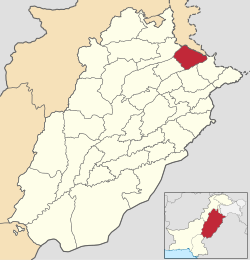Gujrat (District)
| Gujrat District | |
| State : |
|
| Province : | Punjab |
| Seat : | Gujrat |
| Coordinates : | 32 ° 35 ′ N , 73 ° 45 ′ E |
| Area : | 3 192 km² |
| Residents : | 2,756,110 (2017) |
| Population density : | 863 inhabitants per km² |
| Time zone : | PST ( UTC + 5 ) |
| Website : | |

|
|
The Gujrat District is an administrative district in Pakistan in the Punjab Province . The seat of the district administration is the city of the same name, Gujrat .
The district has an area of 3,192 km² and, according to the 2017 census, 2,756,110 inhabitants. The population density is 863 inhabitants / km². The Panjabi language is spoken by the majority in the district .
location
The district is located in the north of the Punjab Province, which is in the west of Pakistan. Gujrat is located between the two famous rivers Jhelam and Chanab . The district is bounded to the northeast by Mirpur , to the northwest by the Jhelam River, which separates it from the Jhelam District , to the east and southeast by the Chenab River, which separates it from the Gujranwala and Sialkot districts , and to the west by Mandi Bahauddin .
Administrative division
The district is administratively divided into four tehsil :
Demographics
Between 1998 and 2017, the population grew by 1.57% annually. About 30% of the population live in urban areas and about 70% in rural areas. 1,335,339 men, 1,420,628 women and 143 transgender people live in 442,399 households , resulting in a gender ratio of 94 men per 100 women and thus a rare surplus of women for Pakistan.
The literacy rate in the years 2014/15 among the population over 10 years of age was 75% (women: 71%, men: 80%) and thus well above the average of the Punjab province of 63%.
| year | population |
|---|---|
| 1972 | 1,177,345 |
| 1981 | 1,408,585 |
| 1998 | 2,048,008 |
| 2017 | 2,756,110 |
Web links
Individual evidence
- ↑ a b DISTRICT WISE CENSUS RESULTS CENSUS 2017. August 29, 2017, accessed May 30, 2019 .
- ↑ Pakistani Districts wise Population Census 2017. Accessed May 30, 2019 .
- ^ Pakistan Bureau of Statistics (2016). Pakistan Social and Living Standards Measurement Survey 2014-15. Government of Pakistan, accessed June 29, 2019 .